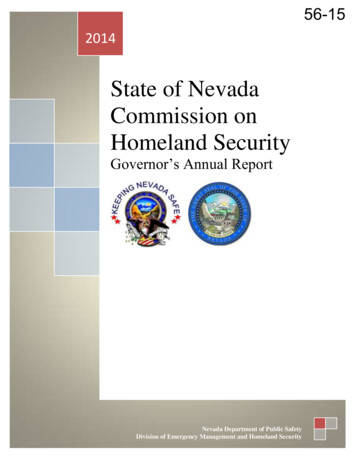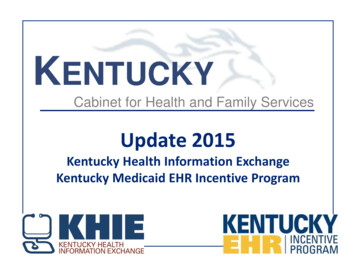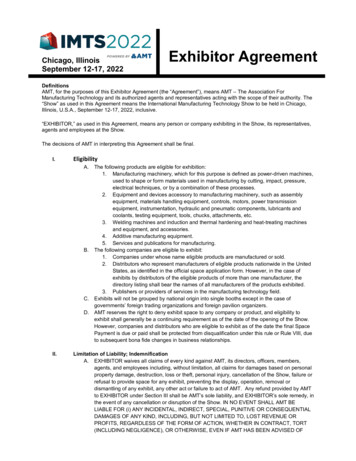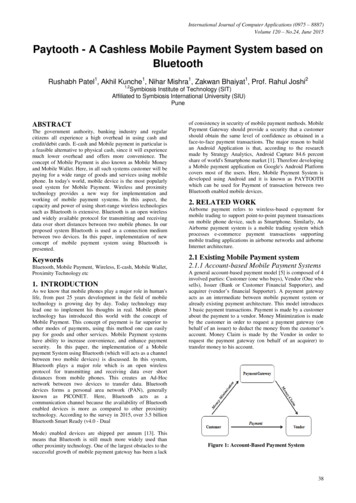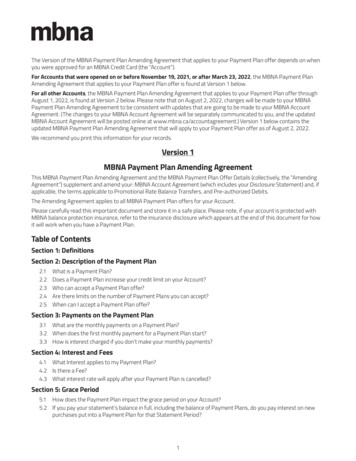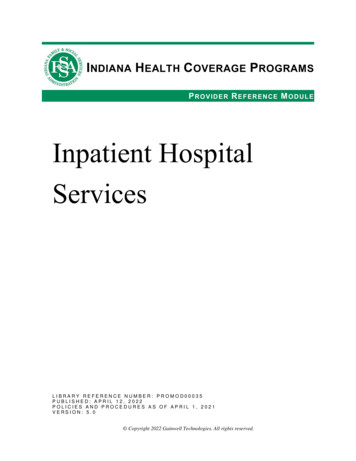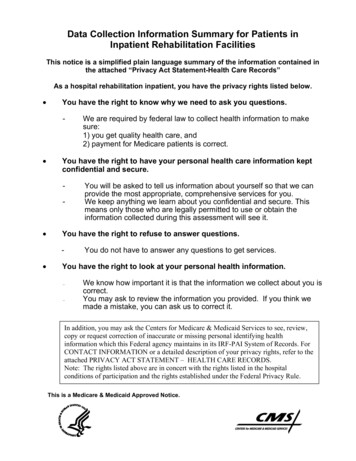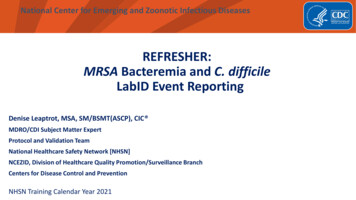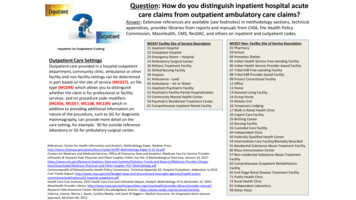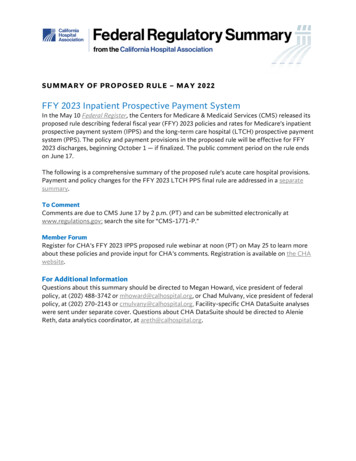
Transcription
SUMMARY OF PROPOSED RULE – MAY 2022FFY 2023 Inpatient Prospective Payment SystemIn the May 10 Federal Register, the Centers for Medicare & Medicaid Services (CMS) released itsproposed rule describing federal fiscal year (FFY) 2023 policies and rates for Medicare’s inpatientprospective payment system (IPPS) and the long-term care hospital (LTCH) prospective paymentsystem (PPS). The policy and payment provisions in the proposed rule will be effective for FFY2023 discharges, beginning October 1 — if finalized. The public comment period on the rule endson June 17.The following is a comprehensive summary of the proposed rule’s acute care hospital provisions.Payment and policy changes for the FFY 2023 LTCH PPS final rule are addressed in a separatesummary.To CommentComments are due to CMS June 17 by 2 p.m. (PT) and can be submitted electronically atwww.regulations.gov; search the site for “CMS-1771-P.”Member ForumRegister for CHA’s FFY 2023 IPPS proposed rule webinar at noon (PT) on May 25 to learn moreabout these policies and provide input for CHA’s comments. Registration is available on the CHAwebsite.For Additional InformationQuestions about this summary should be directed to Megan Howard, vice president of federalpolicy, at (202) 488-3742 or mhoward@calhospital.org, or Chad Mulvany, vice president of federalpolicy, at (202) 270-2143 or cmulvany@calhospital.org. Facility-specific CHA DataSuite analyseswere sent under separate cover. Questions about CHA DataSuite should be directed to AlenieReth, data analytics coordinator, at areth@calhospital.org.
Summary of FFY 2023 IPPS Proposed RuleMay 2022Page 2ContentsProposed FFY 2023 Payment Changes . 7Retrospective Coding Adjustment . 7Effects of the Inpatient Quality Reporting (IQR) and Electronic Health Records (EHR) IncentivePrograms . 7Impact Analysis — California . 8Outlier Payments . 9Medicare DSH — Uncompensated Care DSH . 9Proposed FFY 2023 Factor 1 . 11Proposed FFY 2023 Factor 2 . 11Proposed Factor 3 for FFY 2023 . 11Proposed Scaling Factor . 12New Hospital for Purposes of Factor 3 . 12Newly Merged Hospitals . 13Proposed CCR Trim Methodology. 13Per Discharge Amount of Interim UCC Payments . 13Process for Notifying CMS of Merger Updates and to Report Upload Issues . 141115 Waiver Days in the Medicaid Fraction . 14Updates to MS-DRGs . 14Proposed Cap for Relative MS-DRG Weight Reductions . 16CAR-T Cell Therapies . 16New Technology Payments . 16New COVID-19 Treatment Add-on Payments Extend through the End of the PHE . 17Request for Information (RFI): Social Determinants of Health (SDOH) Diagnosis Codes . 17Proposed FFY 2023 Wage Index. 18Core-Based Statistical Areas (CBSAs) for the Proposed FFY 2023 Hospital Wage Index . 18Worksheet S-3 Wage Data . 18Occupational Mix Adjustment . 18Rural Floor . 19Imputed Floor . 19Frontier Floor Wage Index . 19Revisions to FFY 2023 Wage Index Based on Geographic Reclassifications . 20
Summary of FFY 2023 IPPS Proposed RuleMay 2022Page 3Lugar Hospitals and Counties . 20Outmigration Adjustment . 20Reclassification from Urban to Rural . 21Process for Requests for Wage Index Data Corrections . 21Labor Related Share . 21Permanent Cap on Wage Index Decreases . 22Continuation of the Low Wage Index Hospital Policy . 22Rural Referral Center: Annual Updates to Case-Mix Index and Discharge Criteria . 23Low-Volume Hospital Adjustment. 23Medicare-Dependent Small Rural Hospitals (MDH) . 24Indirect and Direct Graduate Medical Education Costs. 24Weighted GME Count – Hershey v. Becerra. 24Reasonable Cost Payment for Nursing and Allied Health Education Programs . 26Medicare GME Affiliation Agreements and Rural Training Tracks . 26Rate-of-Increase for TEFRA Hospitals . 27Qualified and Non-Qualified Deferred Compensation Plans . 27Principles. 27Requirements for Non-Qualified and Qualified Deferred Compensation Plans . 28Recognition of Contributions or Payments to Qualified and Non-Qualified DeferredCompensation Plans . 28Documentation Requirements . 28Administrative and Other Costs Associated with Deferred Compensation Plans . 28Treatment of Costs Associated with the Pension Benefit Guaranty Corporation (PBGC) . 28Hospital Performance-Based Quality Programs . 28Hospital Readmissions Reduction Program . 28Hospital 30-Day, All-Cause, Risk-Standardized Readmission Rate (RSRR) followingPneumonia PN Hospitalization measure (NQF #0506) (PN Readmission Measure) . 29Technical Updates to All HRRP Measures . 30Clarification of the Extraordinary Circumstance Exception (ECE) Policy for the HRRP . 30Request for Public Comment on Possible Future Incision of Health Equity Performance in theHRRP . 30Hospital VBP Program . 30
Summary of FFY 2023 IPPS Proposed RuleMay 2022Page 4Proposed Hospital VBP Program Measure Suppression and Technical Updates in Responseto the COVID-19 PHE . 31Proposed Special Scoring Rule for FFY 2023 . 31Proposed Performance and Baseline Periods . 32Proposed Performance Standards . 32Request for Information on Future Adoption of New NHSN HAI Digital Quality Measures . 32Hospital-Acquired Conditions (HAC) Reduction Program. 33HAC Reduction Program Flexibility in Response to COVID-19 PHE for FY 2023 . 33Proposed Updates to CMS PSI 90 Case Volume . 33No Mapped Locations Policy . 34HAI Data Submission Requirements for Newly Opened Hospitals. 34Request for Information on Future Adoption of New NHSN HAI Digital Quality Measures . 34Hospital IQR Program . 34New Measures into the Hospital IQR Measure Set . 35Hospital Commitment to Health Equity . 35Screening for Social Drivers of Health . 36Screen Positive Rate for Social Drivers of Health. 37Cesarean Birth eCQM . 37Severe Obstetric Complications eCQM . 38Hospital Harm — Opioid-Related Adverse Events eCQM (NQF #3501e). 39Global Malnutrition Composite Score eCQM (NQF #3592e) . 39Hospital-Level, Risk Standardized Patient-Reported Outcomes Performance Measure(PRO PM) Following Elective Primary Total Hip Arthroplasty (THA) and/or Total KneeArthroplasty (TKA) (NQF #3559). 40Medicare Spending Per Beneficiary (MSPB) Hospital (NQF #2158) . 40Hospital-Level Risk-Standardized Complication Rate (RSCR) Following Elective PrimaryTHA/TKA (NQF #1550) (THA/TKA Complication Measure) . 41Proposed Refinements to Current IQR Program Measures . 41Proposed Establishment of a Publicly Reported Hospital Designation to Capture the Quality. 42and Safety of Maternity Care . 42RFI: Additional Activities to Advance Maternal Health Equity . 42Future Measures Under Consideration. 42
Summary of FFY 2023 IPPS Proposed RuleMay 2022Page 5Reporting and Submission Requirements for eCQMs . 43Reporting and Submission Requirements for Hybrid Measures. 43Reporting and Submission Requirements for Patient-Reported Outcome-Based PerformanceMeasures (PRO-PMs) . 44eCQM Validation Requirements . 44Quality Program Requests for Information . 44Current Assessment of Climate Change Impacts on Outcomes, Care, and Health Equity RFI . 44Measuring Health Care Quality Disparities Across CMS Quality Programs RFI . 44Continuing to Advance Digital Quality Measurement and the Use of Fast HealthcareInteroperability Resources (FHIR) in Hospital Quality Programs RFI. 45Advancing the Trusted Exchange Framework and Common Agreement (TEFCA) RFI. 45PPS-Exempt Cancer Hospital Quality Reporting Program. 45Proposed Revision to Measure Removal Policy . 46Public Reporting of Measure Results . 46Potential Future Digital HAI Measure Adoption RFI . 46Medicare Promoting Interoperability Program . 46Reporting Periods for 2023 and 2024 . 47Electronic Prescribing Objective Proposals . 47Mandatory Reporting of Query of Prescription Drug Monitoring Program (PDMP) Measure. 47Proposed Technical Update to the E-Prescribing Measure . 47Health Information Exchange (HIE) Objective Proposals . 48Proposed Addition of an Alternative Measure for Enabling Exchange Under the TrustedExchange Framework and Common Agreement (TEFCA) . 48Public Health and Clinical Data Exchange Objective Proposals . 49Proposed Antimicrobial Use and Resistance (AUR) Surveillance Measure . 49Proposed Revisions to Active Engagement . 49Public Health Reporting and Information Blocking . 50Proposed Changes to the Scoring Methodology for the EHR Reporting Period in 2023 . 50eCQM Reporting for Hospitals and CAHs Under Promoting Interoperability Programs . 52Proposed Public Reporting of Promoting Interoperability Program Data . 52Condition of Participation: Reporting COVID-19 and Influenza Infections. 52
Summary of FFY 2023 IPPS Proposed RuleMay 2022Page 6RFI: Payment Adjustments for Domestically Made N95 Respirator Masks . 54Appendix — Quality Reporting Program Tables . 56Table 1 . 56Table 2 . 58Table 3 . 59Table 4 . 60
Summary of FFY 2023 IPPS Proposed RuleMay 2022Page 7Proposed FFY 2023 Payment ChangesThe table below lists the federal operating and capital rates proposed for FFY 2023 compared tothe rates currently in effect for FFY 2022. These rates include all market basket increases andreductions as well as the application of annual budget neutrality factors. These rates do notreflect any hospital-specific adjustments (e.g., penalty for non-compliance under the IQRProgram and EHR Meaningful Use Program, quality penalties/payments, disproportionate sharehospital (DSH), etc.).Federal Operating RateFederal Capital RateFinalFFY 2022Proposed FFY 2023Percent Change 6,121.65 6,315.77 3.17% 472.59 480.29 1.63%The following table provides details for the proposed annual updates to the inpatient federaloperating, hospital-specific, and federal capital rates for FFY 2023.FederalOperating RateMarket basket/Capital Input Price Index updateACA-Mandated Productivity AdjustmentMACRA-Mandated RetrospectiveDocumentation and Coding AdjustmentHospitalSpecific RatesFederal CapitalRate 3.1% 1.7%-0.4 percentage point (PPT)— 0.5%——Lowest Quartile Wage Index Adjustment 0.02%Wage Index Cap Policy-0.03%MS-DRG Weight Cap Policy-0.02%-0.02%Annual Budget Neutrality Adjustments-0.01%-0.02%Net Rate Update 3.17%-0.03% 2.66% 1.63%Retrospective Coding AdjustmentCMS is proposing a retrospective coding adjustment of 0.5% to the federal operating rate in FFY2023 as part of the sixth and final year of rate increases tied to the American Taxpayer Relief Act(ATRA). The initial coding offset rate increase was authorized as part of ATRA, which requiredinpatient payments to be reduced by 11 billion over a four-year period, resulting in a cumulativerate offset of approximately -3.2%.Effects of the Inpatient Quality Reporting (IQR) and Electronic Health Records (EHR)Incentive ProgramsThe IQR market basket (MB) penalty imposes a 25% reduction to the full MB and the EHRMeaningful Use penalty imposed a 75% reduction to the full MB; therefore, the entirety of the fullMB update is at risk between these two penalty programs. A table displaying the variousproposed update scenarios for FFY 2023 is below:
Summary of FFY 2023 IPPS Proposed RuleMay 2022Page 8NeitherPenaltyNet Federal Rate Market Basket Update (3.1%MB less 0.4 PPT productivity adjustment)Penalty for Failure to Submit IQR Quality Data(25% of the base MB Update of 3.1%)Penalty for Failure to be a Meaningful User ofEHR(75% of the base MB Update of 3.1%)Adjusted Net Market Basket Update(prior to other adjustments)IQRPenaltyEHR MUPenaltyBothPenalties PT 2.7% 1.925% 0.375%-0.4%CMS estimates that 25 hospitals will not receive the full MB rate of increase because they failedthe quality data submission process or chose not to participate in IQR; 158 hospitals will notreceive it because they are not meaningful EHR users; and 19 hospitals are estimated to besubject to both reductions.Impact Analysis — CaliforniaThe CHA DataSuite analysis estimates that California hospitals will experience an increase of 476 million ( 4.1%) in overall Medicare hospital inpatient payments in FFY 2023, as compared toFFY 2022. However, the impact will vary based on the type of hospital.
Summary of FFY 2023 IPPS Proposed RuleMay 2022Page 9CMS’ detailed impact estimates are displayed in Appendix A of the proposed rule (page 28705),which is partially reproduced below.Hospital TypeAll ProposedRule ChangesAll HospitalsUrbanUrban PacificRuralRural Pacific1.4%1.4%1.3%1.1%2.3%Outlier PaymentsCMS continues to believe that using a methodology that incorporates historic cost report outlierreconciliations to develop the outlier threshold is a reasonable approach and would provide abetter predictor for upcoming fiscal year. Therefore, for FFY 2023, CMS is proposing toincorporate total outlier reconciliation dollars from the FFY 2017 cost reports into the outliermodel using a similar methodology to FFY 2022.Analysis done by CMS determined outlier payments at 5.11% of total IPPS payments; CMS isproposing an outlier threshold of 43,214 for FFY 2023, which includes a charge inflation factorthat is proposed to be calculated using the March 2019 MedPAR file of FFY 2018 charge data andthe March 2020 MedPAR file of FFY 2019 charge data. This proposed threshold is 39.45% higherthan the current (FFY 2022) outlier threshold of 30,988.Medicare DSH — Uncompensated Care DSHMedicare makes DSH and uncompensated care (UCC) payments to IPPS hospitals that serve anumber of low-income patients above a certain threshold. Low income is defined as Medicareeligible patients who also receive supplemental security income, and Medicaid patients who arenot eligible for Medicare. To determine a hospital’s eligibility for DSH and UCC, the proportion ofinpatient days for each of these subsets of patients is used.Prior to 2014, CMS made only DSH payments. Beginning in FFY 2014, the Affordable Care Act(ACA) required that DSH payments equal 25% of the statutory formula and UCC payments equalthe product of three factors: Factor 1: 75% of aggregate DSH payments that would be made under Section1886(d)(5)(F) without application of the ACAFactor 2: The ratio of the percentage of the population insured in the most recentyear to the percentage of the population insured in a base year prior to ACAimplementationFactor 3: A hospital’s UCC costs for a given period relative to UCC costs over thesame period for all hospitals that receive Medicare DSH paymentsThe statute precludes administrative or judicial review of the Secretary’s estimates of the factorsused to determine and distribute UCC payments. UCC payments are made only to hospitalseligible to receive DSH payments that are paid using the national standardized amount.
Summary of FFY 2023 IPPS Proposed RuleMay 2022Page 10Therefore, sole community hospitals paid on the basis of hospital specific rates and hospitals notpaid under the IPPS are ineligible to receive UCC payments.The schematic below describes the DSH payment methodology mandated by the ACA along withhow the program is proposed to change from FFY 2022 to FFY 2023:1. Project list of DSH-eligible hospitals (15% DSH percentage or more) and project total DSHpayments for the nation using traditional per-discharge formula 13.266 B (FFY 2023) ; [ 13.985 B (FFY 2022); 15.171 B (FFY 2021)]Includes adjustments for inflation, utilization, and case mix changes2. Continue to pay 25% attraditional DSH value 3.316 B (FFY 2023); [ 3.496 B(FFY 2022); 3.793 B (FFY2021)]Paid on per-discharge basisas an add-on factor to thefederal amount3a. FACTOR 1: Calculate 75% of total projected DSH payments to fundUCC pool 9.949 B (FFY 2023); [ 10.489 B (FFY 2022); 11.378 B (FFY 2021)]3b. FACTOR 2: Adjust Factor 1 to reflect impact of ACA insuranceexpansion Based on latest CBO projections of insurance expansion, whichincludes estimations due to the COVID-19 PHE 34.29% reduction (FFY 2023); [31.43% (FFY 2022); 27.14% (FFY2021)] 6.538 B to be distributed.3c. FACTOR 3: Distribute UCC payments based on hospital’s ratio of UCC relative to the total UCC for DSHeligible hospitals: 𝑈𝑈𝑈𝑈𝑈𝑈 𝐹𝐹𝐹𝐹𝐹𝐹𝐹𝐹𝐹𝐹𝐹𝐹 2018 𝑈 ��𝐻𝐻𝐻 2019 𝑈 ��𝐻𝐻𝐻 2018 𝑈 19 𝑈 FY 2023 proposes the use of averaged audited 2018 and 2019 Cost Report S-10 UCC DataPaid on per-discharge basis as an add-on factor to the federal amount4. Determine actual DSH eligibility at cost report settlement No update to national UCC pool amount or hospital-specific UCC factors (unless merger occurs)Recoup both 25% traditional DSH payment and UCC payment if determined to be ineligible atsettlementPay both 25% traditional DSH payment and UCC payment determined to be DSH-eligible atsettlement, but not priorThe DSH dollars available to hospitals under the ACA’s payment formula would decrease by 0.654 billion in FFY 2023 relative to FFY 2022 due to a decrease in the pool from projected DSHpayments.The regulatory impact analysis presented in Appendix A of the proposed rule includes theestimated effects of the changes to UCC payments for FFY 2023 across all hospitals by
Summary of FFY 2023 IPPS Proposed RuleMay 2022Page 11geographic location, bed size, region, teaching status, type of ownership, and Medicare utilizationpercent. CMS’ analysis includes 2,380 hospitals that are projected to be eligible for DSH in FFY2023. CMS has made a file available that includes DSH eligibility status, UCC factors, paymentamounts, and other data elements critical to the DSH payment methodology.Proposed FFY 2023 Factor 1CMS estimates this figure based on the most recent data available. It is not later adjusted based onactual data. CMS used the Office of the Actuary’s (OACT) January 2022 Medicare DSH estimates,which were based on the September 2021 update of the HCRIS and the FFY 2022 IPPS final ruleimpact file. Starting with these data sources, OACT applies inflation updates and assumptions forfuture changes in utilization and case-mix to estimate Medicare DSH payments for the upcomingfiscal year.OACT’s January 2022 Medicare estimate of DSH payments for FFY 2023 is 13.266 billion. Theproposed Factor 1 amount is 75% of this amount, or 9.949 billion. The proposed Factor 1 for 2023is about 540 million less than the final Factor 1 for FFY 2022.Proposed FFY 2023 Factor 2Factor 2 adjusts Factor 1 based on the percentage change in the uninsured since implementation ofthe ACA. In 2018, CMS began using uninsured estimates from the National Health ExpenditureAccounts (NHEA) in place of Congressional Budget Office data as the source of change in theuninsured population. The NHEA estimate reflects the rate of uninsured in the U.S. across all agegroups and residents (not just legal residents) who usually reside in the 50 states or the District ofColumbia.For FFY 2023, CMS estimates that the uninsured rate for the historical, baseline year of 2013 was14% and for CYs 2022 and 2023 is 8.9% and 9.3%, respectively. CMS calculates the proposed Factor2 for FFY 2023 (weighting the portion of calendar years 2022 and 2023 included in FFY 2022) asfollows: Percent of individuals without insurance for CY 2013: 14%Percent of individuals without insurance for CY 2022: 8.9%Percent of individuals without insurance for CY 2023: 9.3%Percent of individuals without insurance for FFY 2023 (0.25 times 0.089) (0.75 times0.093): 9.2%Proposed Factor 2 1- ((0.092-0.14)/0.14) 1 - 0.3429 0.6571 (65.71%)CMS calculated Factor 2 for the FFY 2023 proposed rule to be 65.71%, and the UCC amount forFFY 2023 to be 9.949 billion x 0.6571 6.538 billion which is approximately 654 million less thanthe FFY 2022 UCC payment total of about 7.192 billion; the percentage decrease is 9.1%.Proposed Factor 3 for FFY 2023Factor 3 equals the proportion of hospitals’ aggregate UCC attributable to each IPPS hospital.CMS continues to define UCC as the amount on line 30 of Worksheet S-10, which is the cost of
Summary of FFY 2023 IPPS Proposed RuleMay 2022Page 12charity care (line 23) and the cost of non-Medicare bad debt and non-reimbursable Medicare baddebt (line 29). The product of Factors 1 and 2 determines the total pool available for UCCpayments. This result multiplied by Factor 3 determines the amount of the UCC payment thateach eligible hospital will receive.CMS proposes to determine Factor 3 for FFY 2023 using the average of the audited FFY 2018 andFFY 2019 Worksheet S-10 reports instead of basing it on a single year. In addition, CMS proposesfor FFY 2024 and subsequent fiscal years to use a three-year average of the UCC data from thethree most recent fiscal years for which audited data are available to determine Factor 3. CMSbelieves that these proposals address concerns from stakeholders regarding year-to-yearfluctuat
Summary of FFY 2023 IPPS Proposed Rule Page 7 May 2022 Proposed FFY 2023 Payment Changes The table below lists the federal operating and capital rates proposed for .
